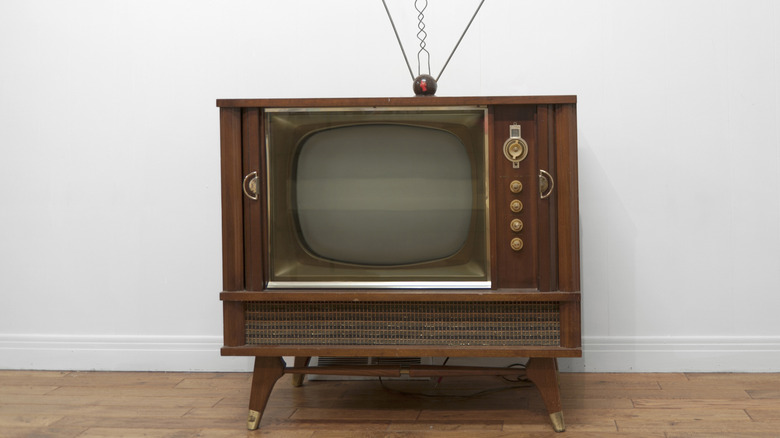Keep Your Retro Aesthetic Authentic With This Hidden Modern TV
We may receive a commission on purchases made from links.
A beautiful old vintage console TV (not an entertainment center, which can be repurposed, too) is an upcycling opportunity waiting for inspiration. Meanwhile, anyone going for a vintage decorating vibe must contend with modern TVs, which (like modern phones) have gone completely the opposite direction, converging into bezel-free digital rectangles with no notable character other than being out of place in any setting. The solution? Put the new TV inside the old TV.
A lot of people have connected these particular dots (for example, a bar fashioned from a TV cabinet by "Fixer To Fabulous"), but the least surprising of them is Lynette Hamblin, who shows off her family's TV project on her @realuphouse TikTok account. Hamblin and her husband built what became the only officially Disney-authorized, lived-in replica of the iconic house from the film "Up!" Sticking a modern, backlit black hole on her wall was obviously not going to do. So she and her husband found what looks like a 1970s Zenith Chromacolor II console TV, gutted it, and replaced it with a 32-inch Samsung N5300 1080p smart TV.
This project is essentially a RestoMod. The term, originally used for automobiles, denotes something that has been restored in design terms but modified with updated components that modernize its performance. There are always trade-offs with RestoMods, and we'll show you how to deal with some of this project's compromises. While it probably won't cost nearly what the least expensive entertainment centers at West Elm will set you back without the TV, the retro gaming craze has increased the price of working CRTs, so look for a broken one.
Building a RestoMod console TV
Making your own modernized console TV starts with a cabinet you love, but pause for a moment before you hit the thrift stores. One of those trade-offs we mentioned is that the aspect ratio of console TVs is much more square than modern displays. You'll have to fit the biggest TV possible horizontally and cover the gaps. Hamblin removed the buttons and dials to the right of the original 4:3 screen to create a space closer to the proportions of the 16:9 smart TV. How you handle this will depend on the design of the cabinet you choose, so bring along a tape measure and examine the console carefully to make sure you'll get what you want from it.
The project itself is fairly simple. Removing the original CRT and tuning/amplification components is just a matter of disconnecting and removing everything, but you must do so with care. CRT TVs can electrocute you if they've been plugged in recently. They can also contain large amounts of lead and mercury, and the CRT itself can explode spectacularly if mishandled. The Hamblins removed all the old works and simply stood the new LCD TV inside the cabinet on its stand. They concealed the gaps and bezel with a surround of thin, period-appropriate trim.
One important complexity to bear in mind is that most LCD TVs have bottom- or rear-firing speakers, which your cabinet can interfere with. It's often trivial to remove and position the speakers behind an improvised grille in your cabinet. If you're not up for that, an external sound bar, like this RIOWOIS Sound Bar for Smart TV, is your best bet.
Making it your own...and even better
There are a lot of ways to customize this project, and TikTok commenters had a lot of great suggestions for improving upon the already-great RestoMod. For example, you might try to find or modify a console so that the TV is behind doors you can close when not watching. You can also convert speaker and storage areas in the cabinet for your own purposes. You should have extra space in the rear of the cabinet, where you can conceal cables and set-top boxes like streaming devices and gaming consoles. Just make sure anything you conceal uses a radio or Wi-Fi remote rather than an infrared remote that requires line-of-sight to function properly.
Some recommend looking for a vintage console stereo instead of a TV cabinet. These wider cabinets are proportioned more like credenzas or sideboards and can really complement aesthetics like mid-century modern. A bit more carpentry might be involved because you don't have an existing TV-shaped opening to take advantage of. Try not to disrupt areas that define the piece's design, like crucial wood panels or areas of grille cloth, often concealing a speaker.
Commenters with longer memories had a few tongue-in-cheek suggestions from the heyday of console TVs, such as putting a smaller TV on top...apparently a common way of dealing with a defunct but much-loved console. A few suggested rounding out the look with a rabbit-ear antenna, complete with aluminum foil extensions for better reception of over-the-air signals. And several suggested making use of kids as lo-fi remote controls, running back and forth to change the channels...whatever those are.

